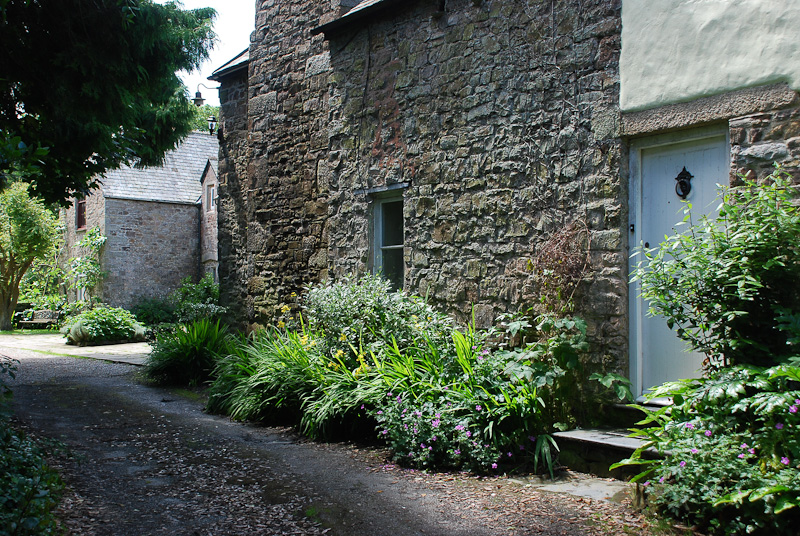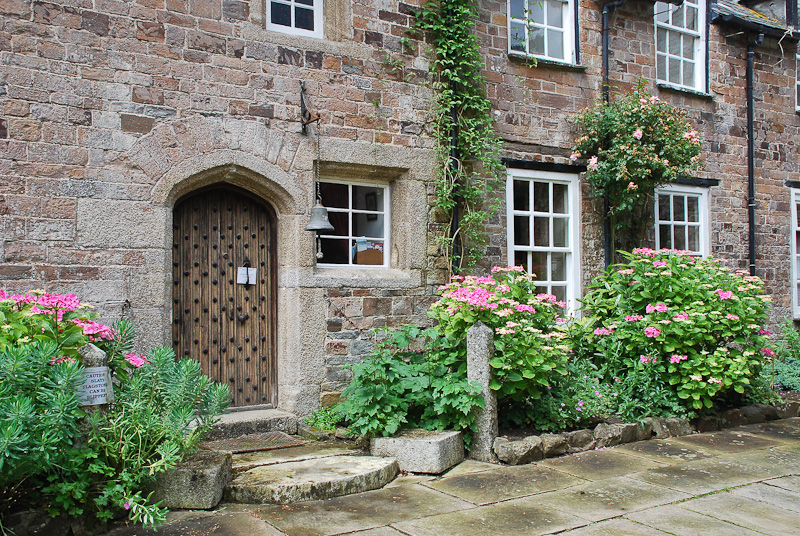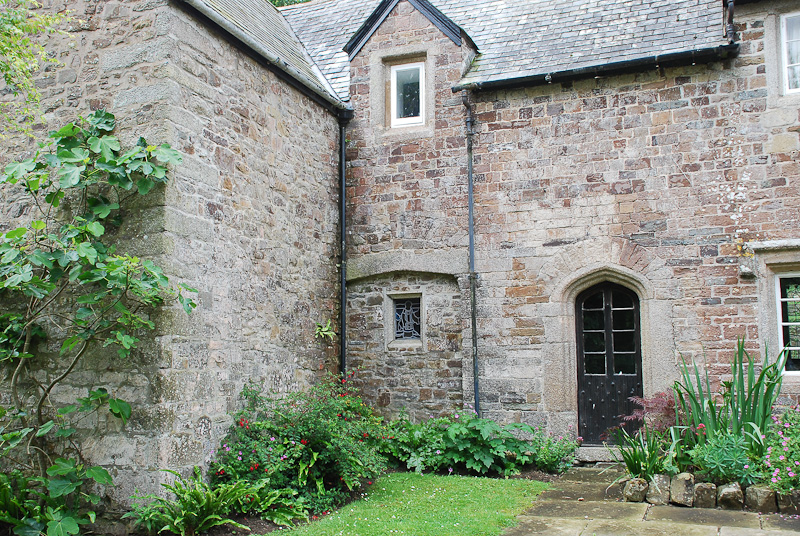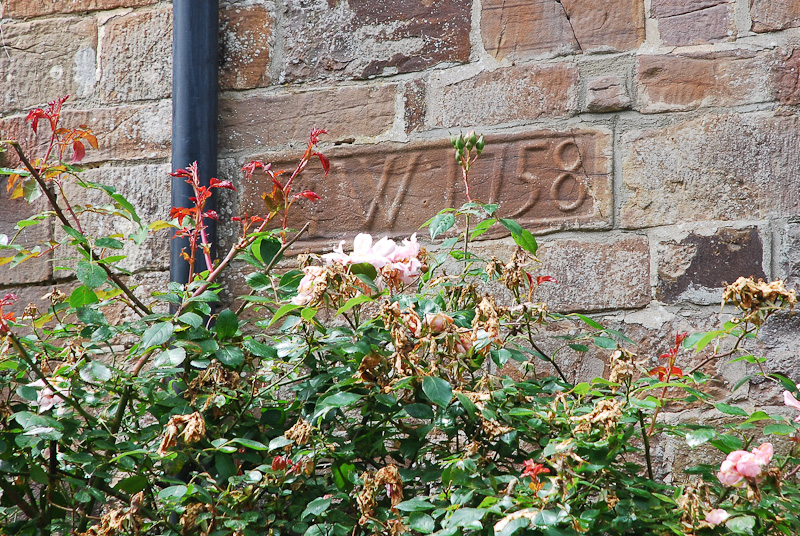
The beautiful old house known as Ebbingford Manor, in Bude, Cornwall, has a number of literary connections and at one time used to open to the public in the summer months. Unfortunately this is no longer the case but the present owner, a local historian who has published several books about the town and the surrounding area, kindly allowed me to take these pictures during a visit in July 2012.
The first recorded mention of Ebbingford dates from 1183. In 1433 the Manor passed into hands of the Arundell family and in 1602 the Cornish antiquary, Richard Carew, mentioned it in his Survey of Cornwall :
‘Returning to the Westwards, wee meete with Bude, an open sandie bay, in whose mouth riseth a little hill, by euerie sea-floud made an Iland, and thereon a decayed Chapell : it spareth roade only to such small shipping, as bring their tide with them, and leaveth them drie, when the ebbe hath carried away the Salt water. Upon one side hereof, Master Arundel of Trerice possesseth a pleasant-seated house and demaines, called Efford, alias, Ebbingford, and that not unproperly, because euerie low water there affordeth passage to the other shore : but now it may take a new name, for his better plight : for this Gentleman hath, to his great charges, builded a Salt-water mill athwart this Bay, whose causey serveth, as a verie convenient bridge, to save the way-farers former trouble, let, and daunger. . .’
One of the pivotal scenes in Daphne du Maurier’s civil war novel, The King’s General, takes place a few miles north of Ebbingford. In May 1628 the heroine, Honor Harris, is staying at Stowe, the home of the Grenvilles, when she rides out with a hunting party in ‘the open country, towards the shore’ and her life changes forever. The two grand properties of the Grenvilles are long gone and only farm buildings remain now at Stowe Barton but Daphne du Maurier visited Ebbingford and it’s easy to imagine how much it would have appealed to her sense of history and love of all things Cornish.
Charlotte Eliza Rawleigh I’ans and Hawker of Morwenstow
In the early 19th century the Manor was let to Colonel Wrey I’ans of Whitstone, Cornwall. The Colonel died in 1816, leaving four daughters ‘verging on middle age but very charming and accomplished’, who continued to use the house as their summer residence. According to Robert Stephen Hawker’s son-in-law and biographer, C. E. Byles, the teenage poet’s friendship with Colonel I’ans and reliance on the family’s library as an aid to his studies gradually developed into a warm relationship with the sisters and a particular affinity with one of them.
Charlotte Eliza Rawleigh I’ans of Ebbingford and Whitstone married Robert Stephen Hawker on 6 November 1823. Charlotte was forty-one and her bridegroom was a nineteen-year-old student at Pembroke College, Oxford. The ceremony took place in Stratton and was performed by Robert’s father, Jacob Hawker. In Sabine Baring-Gould’s semi-fictional account of R. S. Hawker’s life, The Vicar of Morwenstow, he describes Robert’s proposal of marriage in colourful terms and claims that on his part the match was strictly mercenary. It’s difficult to understand why Baring-Gould, a clergyman himself and by all accounts a fond husband to his own less than conventionally chosen wife, should see fit to establish such a churlish legend, but despite protests from family and friends it was reprinted in subsequent editions and still turns up occasionally on websites or in tourist guides to the district.
In the Athenaeum of 25 March 1876 the writer and antiquary, William Maskell, a resident of Bude and friend of R. S. Hawker, wrote :
‘The whole story is a myth, and it is wonderful that Mr. Gould should have idly allowed himself to repeat such a fiction. The run, hatless, for a couple of miles has no foundation beyond the invention of Mr. Gould’s informant. Neither was Miss I’Ans ‘his godmother,’ nor had she ‘taught him his letters.’ The two had never seen each other until Robert Hawker was at least eight years old, and after that, for years, he had been often thrown into her society, and grown up in habits of frequent intimacy and with increasing feeling of regard. The marriage was nothing but the common story of a young man marrying a woman considerably older than himself; and Charlotte I’Ans, at forty, was a person of considerable attractions, well educated, fond of literature, a good companion, and in every respect a lady. She was suited to be the wife of such a man ; and they lived together for nearly forty years in harmony and affection. Mrs. Hawker had always the truest regard for, and admiration of, her husband ; and, on his part, he never seemed to tire of paying her every attention and kindness in his power.’
A short biography of Charlotte I’ans can be found on the Robert Stephen Hawker website along with a list of her published works and an illustration showing Ebbingford Manor as it appeared circa the end of the 19th century. Much of Charlotte’s time after her marriage seems to have been taken up with parish duties but two books of translations of works by the German poet Guido Gorres were published under her name and a few of her translations of poetry appeared in magazines. A footnote to a poem called ‘The Wreck’, first published in R. S. Hawker’s Ecclesia (1840) and reprinted in Cornish Ballads & Other Poems (1904) reads: ‘In his own copy of Ecclesia, Hawker has written “by C. E. H.” (his first wife) against this poem. In another copy of the book is a pencil note in his hand as follows : “written by Mrs. Hawker, except the last three stanzas, which are mine – R. S. H”.
The Bodleian library have several of Charlotte’s letters in their collection of R. S. Hawker material, and Piers Brendon includes a short extract from one of them in his biography, Hawker of Morwenstow: Portrait of a Victorian Eccentric. Brendon presumably had access to the remaining letters while he was writing his book and his references to Charlotte’s ‘quiet but sharp sense of humour’ and ‘Jane-Austenish amusement at the jockeying for social advantage in the Morwenstow neighbourhood’ left me eager to read more.
Lois Ijams Hartman, an American descendent of the I’ans family has researched their history and recorded her findings in a 78-page pamphlet, Remembered in this Land. Her visits to Ebbingford are described in that account and she later used the same material as the basis for a novel, published under the title Footprints Beside Him: a poignant love story of the Cornish coast and later republished as The Vicar’s Wife. More information on all three books can be found in the Books section of the R. S. Hawker website.
George Mills, Arthur F. H. Mills and Reverend Barton R. V. Mills
Sir Thomas Acland built the church of St. Michael and All Angels on the hill behind the Manor in 1835. In 1861 he gave the house to the Church Commissioners for use as a vicarage and between 1896-1901 Ebbingford was home to the Reverend Barton Mills and his young family. Rev. Mills was the author of The Marks of the Church and Other Sermons, and joint editor of Select Treatises of St. Bernard of Clairvaux, and both his sons became writers. George Ramsay Acland Mills (1896-1972) is best known for his series of boys’ adventure stories, including Meredith and Co. (1933) and King Willow (1938). George’s half-brother, Arthur Frederick Hobart Mills (1887-1955) published With My Regiment: From the Aisne to La Bassée and Hospital Days, the latter under the pseudonym Platoon Commander, as well as numerous crime and adventure novels which, although popular at the time, are now largely forgotten. The website ‘Who is George Mills’ has an impressive collection of information on the Mills family and is recommended to anybody wanting to learn more.
The fact that Ebbingford Manor was known at one stage as Efford Manor sometimes leads to confusion. Arthur Mills MP, George and Arthur’s paternal grandfather and a leading figure in Bude during the latter part of the nineteenth century, did not live at Ebbingford although his portrait hangs there. The Mills family home in Bude was at Efford Down House, a Victorian mansion situated on the downs above St Michael’s Church, now converted into flats.

The Dudley Stamp Family
According a 1970’s guidebook, Sir Laurence Dudley Stamp (1898-1966) acquired Ebbingford Manor in 1953 ‘after a splendid Christmas dinner with the then vicar, Canon Walter Prest’, during which they decided to switch their Bude houses. Sir Laurence was an internationally known geographer and director of the 1930s Land Utilisation Survey of Britain, sometimes referred to as ‘a modern Domesday book’. A selected list of his many published works can be found on Wikipedia and his papers are held at the University of Sussex. The Dudley Stamp Memorial Trust provides small grants for geographers to assist them in postgraduate research or study travel likely to lead to the advancement of geography and to international co-operation in the study of the subject. Sir Laurence’s son, Bryan Dudley Stamp, is the co-author of The Book of Bude and Stratton (with Rennie Bere) and Bude Canal: Past & Present, Bude’s Maritime Heritage and Stratton Past & Present (with Bill Young). Bryan also wrote the guide book for the house upon which this article is based and I’m very grateful to him for allowing me to take pictures and share some of his stories.
Text and photos © Angela Williams 2012, 2013
LINKS
– Ebbingford Manor at British Listed Buildings
– The Robert Stephen Hawker website
– William Maskell: a brief biography
– Extract from an obituary for Sir Laurence Dudley Stamp
* * *
At the time of writing a few pictures of the interior of the house can found online via a search for ‘Ebbingford Manor Bude’.





Comments
2 responses to “Ebbingford Manor”
The full name of children’s author George Mills is “George Ramsay Acland Mills,” and both With My Regiment: From the Aisne to La Bassée [Lippincott: Philadelphia, 1916] and Hospital Days [T. Fisher Unwin: London, 1916] were written by Arthur F. H. Mills under the pseudonym “Platoon Commader.” Love this web page… Cheers!
Hi Sam, thanks for spotting that I’d somehow managed to turn Ramsay into ‘Reginald’. Not sure how that happened but I’ve corrected it. Glad you found your way here – I couldn’t have written the section on the Mills family without the help of your excellent website. Keep up the good work!